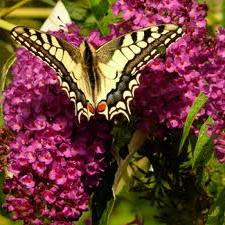 Cherry trees that were protected from our spring chills survived with their fruit intact. Apples and pears also appear to bear very strong harvests, but all fruit trees need protection from hungry birds. ASAP! Fortunately, a little ‘insurance’ goes a long way to guarantee that you will enjoy your blockbuster harvests. If you don’t want your fruit to go the way of Hitchcock’s “The Birds”, put into practice the good suggestions below. All of the methods are tried ‘n’ true and easy to employ.
Cherry trees that were protected from our spring chills survived with their fruit intact. Apples and pears also appear to bear very strong harvests, but all fruit trees need protection from hungry birds. ASAP! Fortunately, a little ‘insurance’ goes a long way to guarantee that you will enjoy your blockbuster harvests. If you don’t want your fruit to go the way of Hitchcock’s “The Birds”, put into practice the good suggestions below. All of the methods are tried ‘n’ true and easy to employ.
Anti-bird methods abound, whether pie pans dangling from limbs or red glass Christmas balls hung from the tree with care, and most of these deterrents are effective. However, none works as well as wrapping each tree in bird netting. This one-inch-square mesh plastic netting is highly effective on newer trees and on semi-dwarf varieties and smaller.
If you have large trees straining under bumper crops, you’ll need to turn to bird tape. This flexible foiled tape glitters in the sun with apple red painted on one side and spaceship silver on the other. As the wind flutters the tape strands in the trees, the birds are too nervous to eat very many fruits. It scares off birds before they eat too much, reducing the number of fruits damaged.
Scarecrows, molded owls and hawks not only keep smaller birds off of fruit trees, but also deter garden rodents. Especially effective are owls made with glass eyes and bobble heads. Whether using scarecrows, owl or hawk replicas, the secret is to not keep them in the same place in the yard. Move your scarecrow every few days. By moving your owl it will appear to have been on an evening’s carnal rampage, and the birds will keep their distance! This triple play on the birds keeps them guessing, “is it real, or is it fake?”
~~ ~~ ~~ ~~ ~~ ~~ ~~
 Now, let’s talk about keeping destructive critters out of our gardens. Some repellents work well and others fade far too quickly. In bright sun many lose their effectiveness far sooner than touted on their containers. Better repellents deliver strong repellant action anywhere from 30-60 days. How and when gardeners apply repellents really can enhance their effectiveness. So, thoroughly coat the plants as directed on the packaging, then lightly spritz new growth as it emerges. Relentlessly keep up this ‘repellent pressure’ until the animals are driven to munch on plants in other yards!
Now, let’s talk about keeping destructive critters out of our gardens. Some repellents work well and others fade far too quickly. In bright sun many lose their effectiveness far sooner than touted on their containers. Better repellents deliver strong repellant action anywhere from 30-60 days. How and when gardeners apply repellents really can enhance their effectiveness. So, thoroughly coat the plants as directed on the packaging, then lightly spritz new growth as it emerges. Relentlessly keep up this ‘repellent pressure’ until the animals are driven to munch on plants in other yards!
There are so many home remedies and prepackaged repellents that it is daunting to figure out which work best, but don’t despair: Your mountain gardener to the rescue again! As a garden writer I receive many freebies to test, and receive even more as a nursery owner. Two products rise to the top as champions.
‘Repels All’ by Bonide is the old standby. This multi-purpose, multi-mammal repellent really does what it says. Point made. Part of its deterrence is from the bad taste and equally bad odor that animals detest. This product works so well that it even has a minor javalina repelling action. I’m referring to the garlic and rotten egg smell that also is offensive to gardeners.
 I diligently searched for a repellent that works and has a pleasant smell. It’s ‘Animal Stopper’ to the rescue! You may have noticed that garden marauders avoid the rosemaries, lavenders, and mints in the yard. That’s because, unlike humans, animals do not like the taste of scented herbs. Engineers for a small player in the repellent market figured out how to liquefy herbs so that we could spritz the liquid onto the foliage of our plants. The result: ‘Animal Stopper’. . . sheer brilliance!
I diligently searched for a repellent that works and has a pleasant smell. It’s ‘Animal Stopper’ to the rescue! You may have noticed that garden marauders avoid the rosemaries, lavenders, and mints in the yard. That’s because, unlike humans, animals do not like the taste of scented herbs. Engineers for a small player in the repellent market figured out how to liquefy herbs so that we could spritz the liquid onto the foliage of our plants. The result: ‘Animal Stopper’. . . sheer brilliance!
Scientists figured out which herbs are better at keeping away deer, rabbits, pack rats, even snakes! In general, the ‘Animal Stopper’ line of repellents is highly effective. Of course, if you have javalinas bedding down in the middle of your flowerbed you may need to start by throwing the entire bottle directly at them, then follow up with some sturdy fencing!
There are local plants that naturally resist, and some that actually repel animals from the yard. Next time you visit the garden center ask for a free copy of my list of animal repellent plants. Newly created is a list of rabbit and deer resistant plants, and a more stringent list of javalina resistant plants. All of these handouts are free for the asking.
~~ ~~ ~~ ~~ ~~ ~~ ~~
![]() A digital Garden Club has been started online. Local e-news happenings, garden photos, Q&A, design tips, conversations between gardeners, and more are sent directly from my desktop to yours via email. Whether via smart phone or iPad, with digital access it is easier than ever to share local gardening successes, disasters, even bug identifications. But you need to belong to participate. Ask to join by shooting a quick note to kenlain@wattersgardencenter.com or message through Facebook at facebook.com/watters1815. Gardeners are surprised when I personally respond to their garden comments:)
A digital Garden Club has been started online. Local e-news happenings, garden photos, Q&A, design tips, conversations between gardeners, and more are sent directly from my desktop to yours via email. Whether via smart phone or iPad, with digital access it is easier than ever to share local gardening successes, disasters, even bug identifications. But you need to belong to participate. Ask to join by shooting a quick note to kenlain@wattersgardencenter.com or message through Facebook at facebook.com/watters1815. Gardeners are surprised when I personally respond to their garden comments:)
~~ ~~ ~~ ~~ ~~ ~~ ~~
This week’s Plant of the Week is the pictured magical new butterfly bush rightly named “Magenta Buzz”. But because I am out of space, this week only my garden club members will receive both the photo and description. Join the club to share the conversation!
Until next week, I’ll see you in the garden center.
http://wattersgardencenter.com/2013/fruit-tress-need-protection-from-birds-they-need-it-now/ Fruit Tress Need Protection From Birds & They Need It NOW!

No comments:
Post a Comment